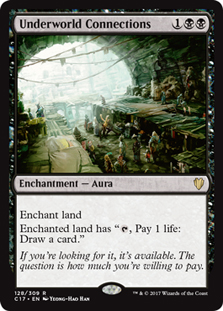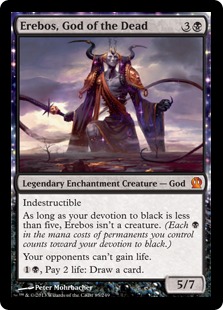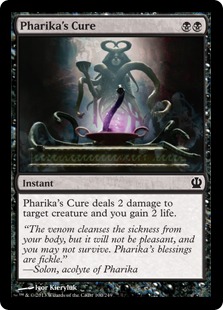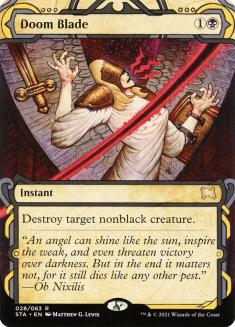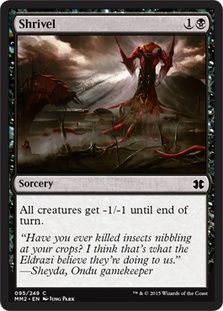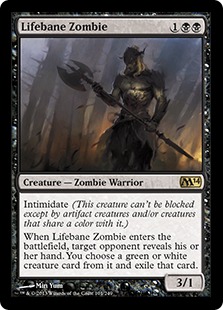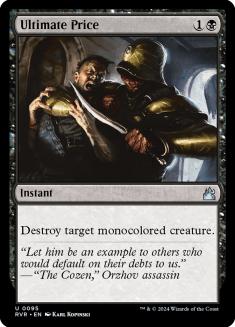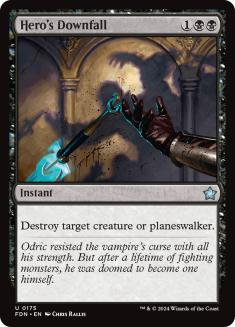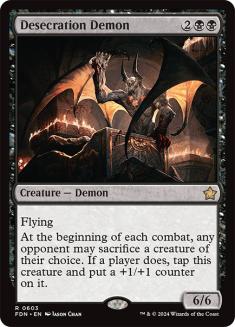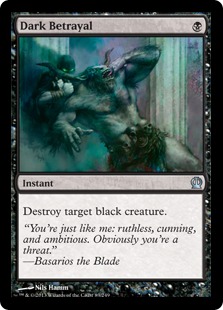Early last week I started to prepare for Grand Prix Albuquerque. Although I had played Esper Control at every major Standard tournament since the Pro Tour, I was both kind of bored of it and didn’t think it was that well positioned. I was mostly deciding between Mono-Blue and Mono-Black Devotion. Paul Rietzl had been practicing a ton and recommended that I try his Mono-Black list. I played with it on Magic Online and liked the deck a lot.
Here’s the version of the deck that both Owen Turtenwald and I played at the Grand Prix:
Creatures (17)
- 4 Pack Rat
- 4 Desecration Demon
- 4 Nightveil Specter
- 4 Gray Merchant of Asphodel
- 1 Erebos, God of the Dead
Lands (26)
Spells (17)
Sideboard

This is very close to Paul’s list. Paul played a Whip of Erebos and a Nykthos, Shrine to Nix where we played a Swamp and a Doom Blade in the maindeck. In the sideboard, we played a Shrivel where Paul played a Doom Blade.
In practicing for and playing in Grand Prix Albuquerque, I learned a lot about the matchups between Mono-Black Devotion and many of the other top decks in Standard. Much like in my articles about Esper, my goal is to break down the ins and the outs of the deck, the matchups, and what your game plan is pre- and post-sideboard.
Mono-Red Aggro
This is a pretty tough matchup and unfortunately often comes down to the strength of the opening hand. It’s important that you have a lot of early interaction in the form of two-mana removal spells. This might go without saying, but being on the play is an enormous advantage. I’ve found that the most difficult draws to beat from the red deck are ones with one or more copies of Burning-Tree Emissary. Sometimes you’re simply going to be overrun with very little you can do about it, and Burning-Tree Emissary promotes that kind of game. It’s important that you aggressively mulligan slow hands, even ones with lands and spells. Something like Swamp, Swamp, Swamp, Swamp, Hero’s Downfall, Underworld Connections, and Desecration Demon is simply not good enough and can almost never win in this matchup. Don’t be afraid to mulligan.
Your primary goal here is to make decisions such that your life total is preserved in the best way possible. Nightveil Specter is a very effective blocker, and at least if your opponent has a card like Lightning Strike or Mizzium Mortars, it will often prevent them from playing another creature that turn. Desecration Demon can be a very big threat and tough to deal with, but only if you’ve been able to do a reasonable job of controlling the board. If your opponent has four or five creatures in play when you play your Demon, it’s often too little too late.
If you’re able to bridge the gap and survive until you’re able to get a Gray Merchant into play, you will often be in good shape. Even if you’re not fully stable, a 2/4 that gains you two life can be tough for the red deck to get through. Usually if you have another creature in play when you play the Gray Merchant, things are going pretty well for you.
Don’t be afraid to block with a 1/1 Pack Rat if your hand is good and you’re going to be able to curve removal spells with really good defensive creatures. If your plan is to make a Pack Rat token for each of the next two turns and then block with a bunch of 3/3s, stop and think how much life it is going to cost you to do so. Oftentimes it’s a lot and just not worth it. Make sure you analyze this situation carefully, as I’ve certainly seen people make the mistake of overcommitting to the Pack Rat and losing the game because of it.
Out
In
There are nine cards in the deck that cause you to lose life: four Underworld Connections; four Thoughtseizes; and one Erebos, God of the Dead. There are only eight cards to board in. Of those nine cards, I prefer to leave one Thoughtseize in the deck. It’s still a decent turn 1 play, it’s really good against a hand with Burning-Tree Emissary, and there’s nothing else that really has a big impact on the game.
In the Grand Prix, I kept wanting to draw Shrivel, and I only had one. I think if I were to play the deck again in the near future I would put a second Shrivel in the sideboard. I’ll have to wait and see how the metagame develops over the next couple weeks to see what I will cut for it, but at that point I’d cut the last Thoughtseize for the second Shrivel.
Lifebane Zombie seems like a weird card to sideboard in since it’s not super high impact against a non-G/W deck. There is the corner case where you get to take a Boros Reckoner or very rarely a Burning-Tree Emissary, which is kind of cool, but really it’s just there because the 3/1 body is better than the other options.
W/R Aggro
The W/R Aggro matchup plays very similarly to Mono-Red Aggro. You want to maintain your life total and control the board the best you can. There are two major differences that you should take note of.
First of all, they have Ajani, Caller of the Pride. What this means is that your Hero’s Downfalls have more utility and can be used to do more than just kill a random creature. Ajani is powerful enough that it will often be in your best interest to cast a two-mana removal spell on turn 3, such as Doom Blade, rather than spending a Hero’s Downfall on one of their creatures. I’m not saying to always hold your Hero’s Downfall for Ajani, just that you can be slightly more mana inefficient to protect yourself from Ajani if the situation warrants it.
Secondly, they have Brave the Elements and Boros Charm. What this means is that you often want to cast removal spells on your turn or during your opponent’s upkeep. This way if they use one of the instants to protect their creatures, it will force them to tap mana on their turn and maybe prevent them from playing another creature. Don’t forget that Boros Charm can even protect Ajani from Hero’s Downfall, so if they have Boros Charm mana it’s generally correct to do that in their upkeep as well.
Out
In
As you can see, I sideboard the same here as I do against Mono-Red Aggro. The big difference is that Lifebane Zombie is actually an incredibly powerful card here and you’re very happy to have it in your deck. Not only does it almost always get a creature, but it allows you to see if they are holding Boros Charm or Brave the Elements so you can play around them as efficiently as possible.
Mono-Blue Devotion
I’ve found that against Mono-Blue Devotion there are two types of games: the games where they have Thassa in play and the games where they don’t.
When the blue player doesn’t have Thassa, either because they haven’t drawn her or because you’ve hit her with Thoughtseize, you are often best served to save your removal spells to use on their best creatures, Nightveil Specter and Master of Waves. Of course, you still need to make sure you don’t get run over in the early game and sometimes you need to kill a 3/4 Cloudfin Raptor, but for the most part after you’ve established a bit of a board presence of your own, cards like Tidebinder Mage, Judge’s Familiar, and Cloudfin Raptor just don’t matter much anymore. Desecration Demon becomes a big threat very fast, especially considering the blue player has very few ways to interact, and as you get more creatures into play, the threat of a Gray Merchant of Asphodel gets closer to lethal.
When Thassa is in play, everything changes. You can’t hold off the blue creatures as well because she can make them unblockable. In addition to that, cards like Tidebinder Mage or Frostburn Weird become major threats just because of their casting costs. You end up having to spend removal spells on them just to keep Thassa from being a 5/5. The blue player is often able to use Thassa’s scry ability to find more devotion cards, and once it’s clear that your removal spells have been depleted (since you aren’t killing creatures to turn Thassa off anymore), a Master of Waves can end things even quicker than Thassa could.
Thassa turns these games into a race, a race that the blue deck is more equipped to win. Be prepared to get very aggressive with your Specters and Demons if the situation warrants it. Even if you don’t have a Gray Merchant in your hand yet, be aware that when you fall too far behind in this matchup Gray Merchant is often the only card that can save you. If you have to take very high-risk lines against Thassa to force a few damage through simply on the hopes that drawing a Gray Merchant in the next couple turns will be lethal, it is often worth it.
Out
In
I side out two Pack Rats on the draw but zero on the play.
Mono-Blue has a lot of fliers and can come out of the gates very fast. I’ve found that while on the play Pack Rat can do a lot of work, and on the draw it doesn’t do nearly as much. Lifebane Zombie is actually a reasonable threat in this matchup since oftentimes the game comes down to a race if they’re able to get a Thassa in play. I could even see an argument for shaving Desecration Demon in favor of Lifebane Zombie in this matchup, but I have yet to pull the trigger on that.
Pharika’s Cure and Doom Blade are both good removal spells and both deal with Master of Waves. Unfortunately neither of them deal with opposing Nightveil Specters, but they are still definitely worth having in your deck.
Underworld Connections and Erebos, God of the Dead are both simply too slow for the matchup. Underworld Connections is certainly very good some percentage of the time, but I feel that is much less common than when it just clutters up your hand or costs you a turn to set up that you should have been using to deal with your opponent’s threats.
Esper Control
Esper Control is always a very difficult deck to play against. Although Mono-Black plays like a control deck in many matchups, against Esper they are certainly the one that needs to play the control game. Your primary route to victory is to use Thoughtseize to clear the way for major threats. If you are activating Underworld Connections, it is often very hard for your opponent to keep any semblance of control of the game. Erebos can also fill a very similar role. Don’t just fire off your Thoughtseize on turn 1 in this matchup. Save it until either the turn before you are planning to cast a major threat or if the situation warrants on the same turn that you are going to play a major threat. Sometimes if you draw a creature heavy hand and there isn’t a single card you really need to resolve, do your best to use your Thoughtseize to fight their Sphinx’s Revelation.
Because Nightveil Specter and Desecration Demon are both so powerful if left unanswered, you can often only commit one creature to the board at a time. Doing so ensures they don’t gain card advantage with Supreme Verdict. Against some decks, an Esper player can easily just take damage from a two-power creature every turn. But against a Nightveil Specter, they run the risk of you being able to cast spells that you take from their deck. Given that you have Temple of Deceit and can hit lands of theirs, they have to be very worried of you being able to cast a card like Jace, Architect of Thought, Divination, or Dissolve. If you can force the Esper player to use Detention Spheres on your creatures, it will make it that much harder for them to deal with an Underworld Connections or Erebos if you’re able to resolve one.
Because Esper has the ability to sweep all your Rats at once, when playing with Pack Rat it is sometimes practical to do things a little differently than you would against other decks. For example, after you have two total Rats in play, you can make a decision. Sometimes that might be enough pressure, and you can force them to deal with them. This is especially true if you have a Mutavault in play, which greatly increases the clock.
Secondly, you can choose to make Rats at the end of the Esper player’s turn instead of during your own attack. If you have two Rats in play and attack and make a Rat on your own turn, that’s six damage. They can then untap and Supreme Verdict or Detention Sphere and three-for-one you. If you wait to make the third Rat at the end of your opponent’s turn, then you are attacking for nine damage. While you can still be the victim of a three-for-one on the following turn, you have done three more damage. Also, if you’ve been able to apply enough pressure or if they’ve taken damage from a shock land, just having the threat of making an end-of-turn Pack Rat token and then another on your turn and attacking for twelve is enough that they will likely be forced to commit something to dealing with only the two Rats.
Out
In
The spot removal spells have very little value in this matchup. Hero’s Downfall is obviously a little bit better since it has the ability to remove planeswalkers. That being said, I think you still want to be sure you have pressure after sideboard, and you don’t want to draw hugely reactive hands. Shaving on the Hero’s Downfalls has worked out well for me so far, as I feel that I am able to fight Jace using creatures and Mutavaults. Elspeth is a lot tougher, but you still have two Downfalls and it is much more of a late game card than Jace is.
You’ll notice that I left the Devour Fleshes in the deck. This is to have an answer to Blood Baron of Vizkopa. This is also the reason that I really like Lifebane Zombie after sideboard against the Esper deck. Blood Baron is very good against you, and having a bunch of answers is useful, especially considering the number of Blood Barons the Esper decks have been packing has been on the rise.
Mono-Black Devotion
The Mono-Black Devotion mirror generally comes down to one of two things: Pack Rat or card advantage.
Pack Rat is an exceptionally potent threat in this matchup. Oftentimes if a player is able to play a Pack Rat on turn 2 and it goes unanswered for a single turn, there is no possibility of catching up. Most Mono-Black decks have six-to-eight total cards that can deal with Pack Rat once it’s in play. For example, from the four Mono-Black decks in the Top 8 of Grand Prix Albuquerque, Owen and Paul had eight (four Hero’s Downfalls, two Devour Fleshes, two Ultimate Price), Todd had seven (four Hero’s Downfalls, two Devour Fleshes, one Ultimate Price) and Joseph had eight (four Hero’s Downfall and four Devour Fleshes). Now, keep in mind that although Hero’s Downfall can technically deal with Pack Rat, if the player with the Pack Rat is on the play a single Hero’s Downfall is too slow.
My use of the phrase "cards that can deal with Pack Rat once it’s in play" was written that way because of Thoughtseize. Every Mono-Black Devotion deck is going to be packing four copies. Largely because of Pack Rat, Thoughtseize is going to be one of the most important cards in the mirror. It has the twofold benefit of being able to strip your opponent’s hand of an otherwise unbeatable Pack Rat or if you’re the one holding the Pack Rat is able to clear the path of potential removal spells.
The non Pack Rat games are usually decided by sheer card advantage. Underworld Connections or Erebos, God of the Dead if unmatched create leads that are generally insurmountable. Due to the fact that Connections and Erebos are both enchantments, Thoughtseize is going to be the only way to reliably deal with them. In theory, Erebos can be dealt with by a Devour Flesh if the player controlling Erebos were to control something like two copies of Underworld Connections, but at that point they are likely extremely far ahead anyway. Nightveil Specter can also play a big role in the card-advantage game. If Nightveil Specter goes unanswered and is able to connect, it is nearly as good as drawing a card.
Out
In
I’ve found that the Demons often don’t have a huge impact in this matchup. Sometimes they do the final damage, but they don’t actually help you get to that point. If you win with Pack Rat, great. If you’re winning the card-advantage game, you can usually cascade Underworld Connections into more Underworld Connections, Specters, discard spells, and Gray Merchants.
Hero’s Downfall is a little slow, and since you’re adding three copies of Dark Betrayal, it is the obvious removal spell to cut for the big upgrade. Obviously Doom Blade is very poor in the matchup since the only target it has is Mutavault.
Duress is sort of like Thoughtseize numbers five through seven; although obviously not as good, it can still fight a turn 3 Underworld Connections from the opponent or be used to protect your Pack Rat or Nightveil Specter.
Erebos is an easy addition since it can both help you win the card-advantage game and negate the life-gain side of your opponent’s Gray Merchant of Asphodel.
I ended up finishing in 29th place Grand Prix Albuquerque with Mono-Black Devotion. While 29th place isn’t what you hope for going into an event, it’s certainly a respectable finish. Grand Prix Dallas is in about a week and a half away, and at this point Mono-Black Devotion is at the top of my list of what deck to play. If you are heading to the StarCityGames.com Open Series in Oakland or to Grand Prix Dallas, I definitely recommend giving Mono-Black Devotion a try.
Before I go, I’d like to say congrats to some of my teammates for another amazing weekend. Congrats to Matt Costa for taking home the SCG Standard Open in Providence with his Jund deck. Congrats to Paul Rietzl for his Top 8 performance in Grand Prix Albuquerque. Congrats to Sam Black for continuing his absurd run by making Top 8 of his fourth premier event in a row in Albuquerque. And, of course, congrats to Owen Turtenwald for winning back-to-back Grand Prix in Washington DC and Albuquerque.
Happy Thanksgiving everyone!

